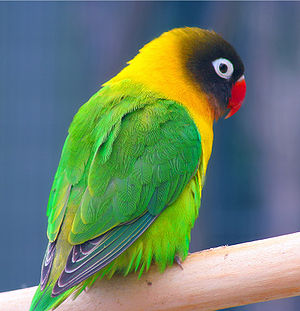Black-headed
| Black-headed | ||||||||||||
|---|---|---|---|---|---|---|---|---|---|---|---|---|

Black-headed ( Agapornis personatus ) |
||||||||||||
| Systematics | ||||||||||||
|
||||||||||||
| Scientific name | ||||||||||||
| Agapornis personatus | ||||||||||||
| Reichenow , 1887 |
The black head ( -Agapornis personatus ) is a kind of the genus of Unzertrennlichen . Together with the other species of this genus, as well as the gray parrot , the long wing parrots , the Rose-ringed Parakeet and Madagascar endemic Vasa Parrots this type is a typical parrot species of Afrotropical .
description
The body plumage has a green basic color, the face and the crown are brown to black. The beak is red and the iris is surrounded by a wide white eye ring. In contrast to soot-heads, black- heads have a bright yellow-colored chest and neck. The tail feathers are green and end in a dull blue. Young animals are more inconspicuously colored, in particular the head is brown. Black heads grow up to 15 cm. The males of this species weigh 50 g. The females are a little heavier at 56 g. They can live between 18 and 20 years of age.
distribution and habitat
The distribution area of the black head extends to Tanzania and the southwestern Zambezi as well as southwestern Kenya . Blackheads were also naturalized in the Nairobi and Dar es Salaam region .
They inhabit grass steppes with a few trees, which mainly consist of baobabs and acacias . They can be found at altitudes from 1100 to 1800 m.
Lifestyle and diet
They are very lively birds that are very affectionate and playful. The females are extremely nimble and often react aggressively to other birds. They also like to bathe. Usually they live together in small groups of 4–5 animals. Sometimes, however, there are also flocks of up to 100 animals.
They feed on grass seeds as well as sorghum .
Reproduction
Blackheads breed in colonies in the dry season from March to August. They prefer nest boxes in knots or niches but also build nests of swifts to kobel shaped nest of which has a side entrance. The nesting material is entered by the female with her beak. This behavior differs from that kind mountain parrot and the Rosenköpfchen which clamp their nesting material in the plumage to take it to the nest cavity. Both partners are involved in nest building.
4 and rarely 5 eggs or more are laid, which are then incubated for 21–23 days. The young are born blind and only open their eyes after approx. 10 days, after approx. 43 days the young are fledged.
Systematic position
In the past two subspecies were distinguished, whereby the nominate form Agapornis personata personata was usually referred to as black-headed and the second subspecies, Agapornis personata nigrigenis, with its significantly less dark plumage, was called soot-head. The soot head is now regarded as an independent species ( Agapornis nigrigenis ).
Sources and References
literature
- Rosemary Low: Das Parrotienbuch , Ulmer Verlag, Stuttgart 1989, ISBN 3-8001-7191-0
- Werner Lantermann : Parrot Studies: Biology - Behavior - Keeping - Species Selection of Parakeets and Parrots , Parey Buchverlag, Berlin 1999, ISBN 3-8263-3174-5
- Georg A. Radtke : Inseparable (Agaporniden): keeping, breeding and color variations , Franckh, Stuttgart 1981, pp. 13–28, ISBN 3-440-04947-7
Individual evidence
Web links
- World Parrot Trust , accessed February 13, 2010
- Agapornis personatus inthe IUCN 2013 Red List of Threatened Species . Listed by: BirdLife International, 2012. Retrieved October 7, 2013.



